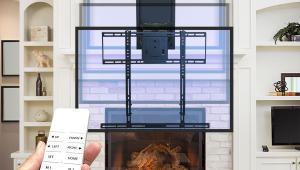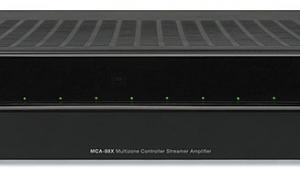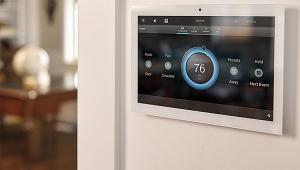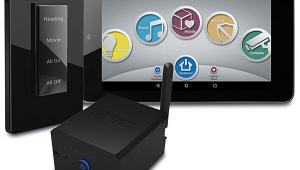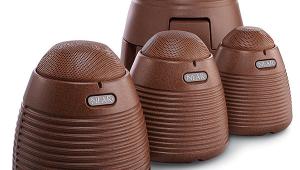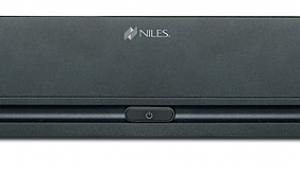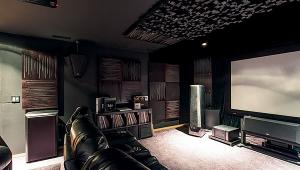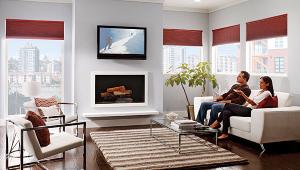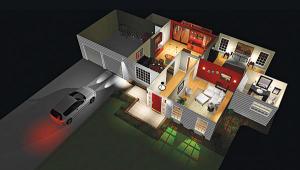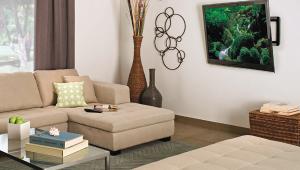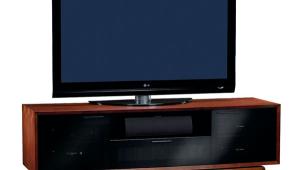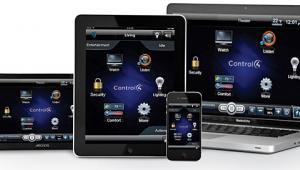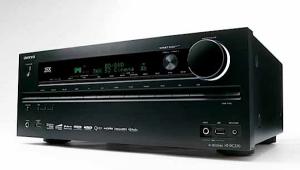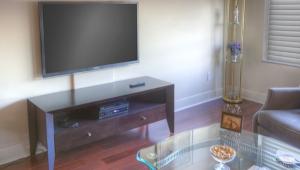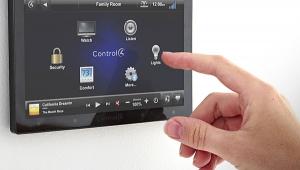Lighting Control: Beyond the Basics
 Everyone's home features lighting control to some extent. Maybe you've taken a step up and can control the level of a light or two with dimmers, but that's about as far as many people get.
Everyone's home features lighting control to some extent. Maybe you've taken a step up and can control the level of a light or two with dimmers, but that's about as far as many people get.
What is an actual lighting-control system, and what can it do for you? A lighting-control system allows you to control the level of multiple lights in your home from one or more locations. The more advanced systems permit you to take it even further, allowing your lighting to change based upon external events or time of day. Lighting-control systems come in many sizes and configurations. You can regulate every last lamp in your house or just a few.
A basic lighting-control system may encompass just one room—say a home theater or media room. For this "wow" effect, you'll also enjoy added conven-ience and gain some nice advantages. One is the ability to achieve the perfect lighting combination, or scene, from your room's lights. You adjust the dimmer controlling each of the lighting circuits (known as "zones" in lighting parlance) to your exact taste, depending on the activity in the room.
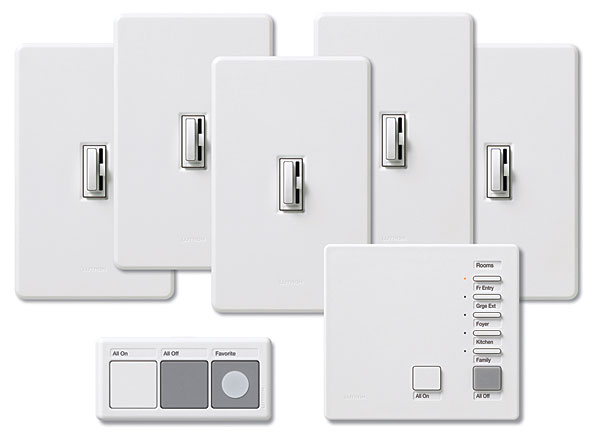
Dimmers
There are several controllers that are designed specifically for single-room applications. Lutron offers their GRAFIK Eye, and LiteTouch offers the Scenario and the new Neo. Known as preset scene controllers, the units are basically multiple dimmers housed in a single unit that fits in a standard electrical wall box. The size of the box depends on the number of lighting circuits you'll be controlling. In their largest configurations, the GRAFIK Eye will control six zones of light, and the Neo can control up to eight zones. The new version of the GRAFIK Eye can also control motorized window shades. Both the GRAFIK Eye and the Neo fit in a four-gang box. In addition to their smaller size, relative to six or eight individual dimmers, these units arguably appear more attractive.
Watching a movie? You can turn most of the lights completely off, with just a soft glow from the can lights in the ceiling. How about inviting some of the guys over for the college football opener? You don't want to sit around in a dark room, but you don't want to wash out the image on the screen, either. With such a system, you can design a setting that works just right for this application by setting the dimmers low or off in the front of the room and higher in the back. When you're cleaning, or the kids are playing video games, you may want all or most of the lights on. No problem.
Gone are the days of remembering exact dimmer settings and then trying to repeat them for each activity. With lighting control, it's as easy as recalling a preset on your car radio. Just touch one button, and the lights will smoothly ramp to where you prefer them. And what if you want to move beyond just a single room to add this sort of convenience to other rooms in your home? Again, no problem; that's what lighting-control systems were made for.
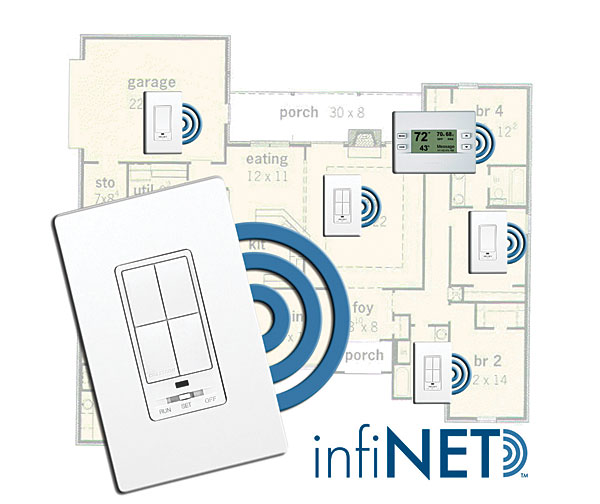
Beyond the Home Theater
When you extend lighting control into other areas of your home, you gain the advantage of magnified convenience. In fact, Lutron sales manager Marc Tieszen states that convenience is the primary reason homeowners purchase wholehouse lighting systems. He cites examples such as the ability to turn all the lights out when going to bed at night, rather than walking through the house and turning lights out; to monitor different areas to see if lighting is on, such as with outdoor lights, garage lights, and a child's bedroom lights (you can make sure the little tykes really have their lights off at 9 p.m.); and to create pathway lighting to the bathroom areas and kitchen areas.
Remember the scene concept from a single-room control system? You can stretch that to include as many rooms as you want. No more going to bed in your upstairs bedroom and remembering you forgot to turn off the lights in the basement rec room and out in the garage. A simple press of a button labeled "Good Night" will take care of setting all the lights in your home just how you'd like them when you retire for the evening. "Goodbye" turns every light off.
Scenes
A very popular lighting scene is one for entertaining. When you've managed to adjust every light in your home just so, you can save the levels of all the lights to a preset. The next time, you simply press a single button before your guests arrive, and the scene will be repeated free of hassle.
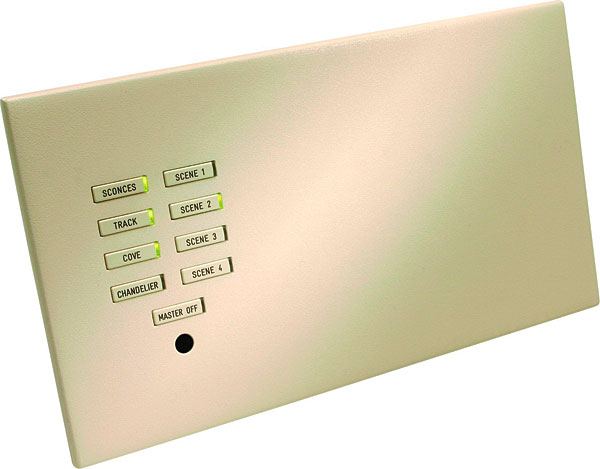
Pathway scenes, as the name suggests, illuminate the line of movement from one area of your home to the next. No more walking into a dark house at night. You can press a button from your car, and a path will light from your garage, through your mudroom, and into your kitchen. They can extinguish automatically at a preset time.
When controlling lights such as those illuminating a landscape, the more sophisticated lighting-control systems allow the use of an astronomic time clock that tracks sunrise and sunset. This capability is quite useful if you want the driveway and landscape lights to come on 30 minutes before sunset, for example. With the astronomic time clock, you aren't limited to events occurring at a certain time of day, although that capability certainly exists as well.
Energy Conservation and Security
Another advantage of a wholehouse lighting-control system is the incorporation of logic into the system's operation so that lights respond differently depending on certain conditions, such as how you're using a particular space or the time of day. For instance, your system can turn on your master bathroom lights to 90 percent during most of the day. Late at night, though, such as between the hours of 11 p.m. and 5 a.m., you may want to set them to only turn on 35 percent to avoid blinding your still-sleeping eyes as you venture to the bathroom.
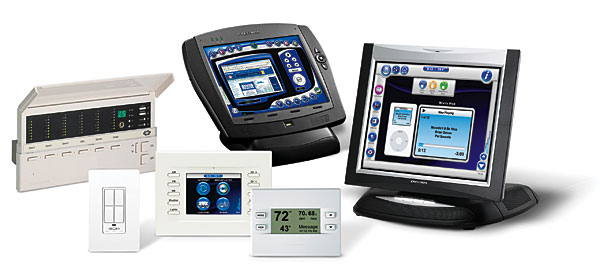
The ability to adjust lighting levels also conserves energy. Why set lights at 90 percent instead of 100 percent? Because setting the lights at 90 percent almost doubles the life of the bulbs—a boon in areas of your home with high ceilings and/or expensive bulbs. No more climbing a ladder, using the suction-cup pole, or renting a lift to get at those can lights in your 24-foot foyer. Do you really think it's safe trying to balance the ladder on the stairs like that? Your installer can program many lighting-control systems to a default "On" setting between 85 and 90 percent.
Furthermore, dimming the lights saves roughly the same amount of electricity as the percentage the lights are dimmed. For example, if you set the lights at 90 percent, you consume about 90 percent of the energy they would require at 100 percent. If you've experienced the price of electricity lately, you'll be able to appreciate that. California, with the adoption of Title 24 in June 2001, requires the installation of dimmers or high-efficacy luminaries (light fixtures) in both commercial and residential buildings as an energy conservation measure. You can bet other states will adopt that type of legislation in relatively short order. The one exception to the dimmer requirement in the California code involves the kitchen, where at least 50 percent of the light fixtures must be of the high-efficacy type, no matter what.
Yet another advantage of lighting-control systems discovered by homeowners pertains to security. You never need to walk into a dark home again; you can simply turn on the lights from a remote in your car or have them triggered when you raise the garage door. In the event that the security system triggers all the home's lights, both interior and exterior will ablaze to frighten off an intruder.
In case of a fire in the home, the smoke will reflect the lights much the same way as fog causes glare from your car's headlights. To combat this phenomenon, you can connect the lighting-control system to your security system and program it to illuminate pathways out of the home. In addition, you can set the lights to only come on to about 50 percent. The combination of the pathway and the dimmed lights help to show you and your family a safe way out of your home, even if it's filled with smoke.
System Types
There are basic types of lighting-control systems: centralized and distributed. In a centralized lighting-control system, as the name suggests, all of the dimming takes place in one or more central locations. Each lighting circuit (say "switch leg" when you're talking to your electrician) is connected to a central lighting-control panel installed with multiple dimming modules. These modules feature the capacity, depending upon the manufacturer and model, to dim several lighting circuits.
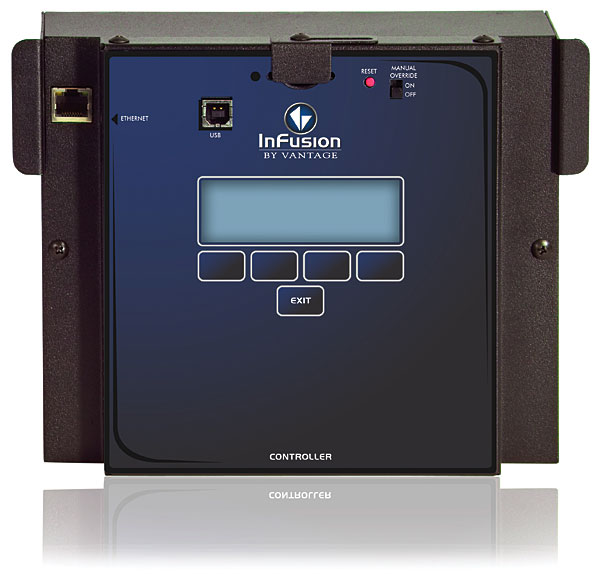
In comparison to the distributed system, on the one hand, the centralized system does not utilize traditional switches or dimmers on the walls because all the switching occurs remotely. This illustrates another advantage of a lighting-control system. Instead of walls with banks of multiple light switches and dimmers, a single, attractive keypad controls all the lights in the room. Interior designers and architects love this. No more ugliness on their walls. Even with a basic, single-room lighting-control system, you can usually hide the dimmers or dimming unit in a closet or other out-of-the-way location and control it with a single keypad. Moreover, a keypad in one room need not only control the lights in that room alone. In addition, you or your installer can reprogram that keypad to control other lights in the event that your requirements or tastes change.
On the other hand, a distributed lighting-control system uses a traditional layout for switches and dimmers. A distributed layout is often the best choice if you're retrofitting a lighting-control system into an existing home. Some people feel more comfortable with a distributed system because it retains the traditional layout. When you walk into a room, you are greeted by a normal-looking dimmer or two. Everyone knows how to use such a system, yet it retains many of the advantages that a centralized system offers, including preset scene control. However, you won't rid your walls of that double bank of six dimmers in the entryway. Nonetheless, you can still incorporate some of the aesthetic benefits of a fully centralized system by relocating some of the dimmers away from congested areas, such as the aforementioned entryway. You may be able to move them to a nearby closet, for example.
Another option, a hybrid system, contains elements of both systems. In rooms with only one or two lights, such as a powder room, you may want to systematically control the lights but retain a traditional switch layout for local control. This will also eliminate the need for an expensive keypad in such a room. Plus, you'll still be able to control the lights in the main areas of the home using centrally located dimmers, as in the fully centralized system.
 Communication
Communication
Most lighting-control systems feature a central processing unit that lets you create and store scenes. The processor allows complex, conditional programming and inputs from external sensors, like door contacts or motion detectors. The control interfaces, such as keypads, are connected to the processor. Communication between the processor, controls, and dimmers or switches can happen in a number of ways. Many systems are hard-wired; they use traditional wiring to connect the devices and route the communication. Hard-wired systems are generally extremely reliable, secure, and relatively cost-effective.
Some systems, particularly those targeted at the retrofit market, use various forms of radio frequency (RF) communication. More recently, RF systems using newer, wireless mesh network technologies, such as ZigBee or other variations, have been introduced. These offer robust communication, reliability, high data rates, and expandability. Each device works as a node on the network that communicates by routing communications through multiple devices until it reaches the destination. Every device in the network is a repeater, so as you add more devices to the system, the communication becomes stronger and more reliable.
As I mentioned above, RF-enabled lighting-control systems remain the systems of choice for retrofit applications, although new-construction applications may also offer them. While it's not technically incorrect to install an RF system in a new-construction project, you will lose the cost and centralization benefits that a traditional system can provide. An RF system's main advantage involves labor savings in a retrofit application, and that advantage evaporates in a new-construction application. In fact, the system may cost more because of the increased price of RF components.
Going Wholehouse
Despite lighting-control systems' amazing capabilities, they reflect but the tip of the iceberg. A lighting-control system can be just one part of a complete home-control system, such as those available from AMX, Crestron, and Control 4, for even more astounding results. One of the most popular applications of a completely integrated system is the ability to integrate lighting into wholehouse scenes. This application saves time, saves money, and enhances your lifestyle.
If you live in a larger home, you know the frustration of making certain everything is turned off. Integration can help you here. Typically, you arm the security system just as you leave your house. If you have an integrated system, the lighting control's "Away" scene can become part of a wholehouse away scene that your security system's "Away" setting will trigger. Voilà! No more running through the house to turn off every light.
Picture this: You arm the security system to the "Away" mode. Knowing you don't do this to enjoy an evening at home, the home-control system deduces that you must be leaving. It recalls the lighting system's "Away" preset, turns off the house music system and all the TVs, sets back the thermostats, lowers the blinds, sets the automatic locks, and opens your garage door so you can ease the Porsche down the driveway; you're fettered only by your imagination and budget.
The line between the home-control system and the lighting-control system is becoming more blurred. A leading lighting-control systems manufacturer, Lutron, has added the ability to control a huge variety of motorized window shades (also available from Lutron) as part of the core functionality of their HomeWorks Interactive lighting-control system. Through serial and contact-closure interfaces, the HomeWorks processor can communicate with other devices to trigger lighting scenes. The lights can go to a preset mode when the security system goes into alarm, for example. Other devices can use the HomeWorks processor to control them as well. Lighting keypad buttons, for one, can turn on your music system, while advanced HomeWorks programming can solve more intricate problems.
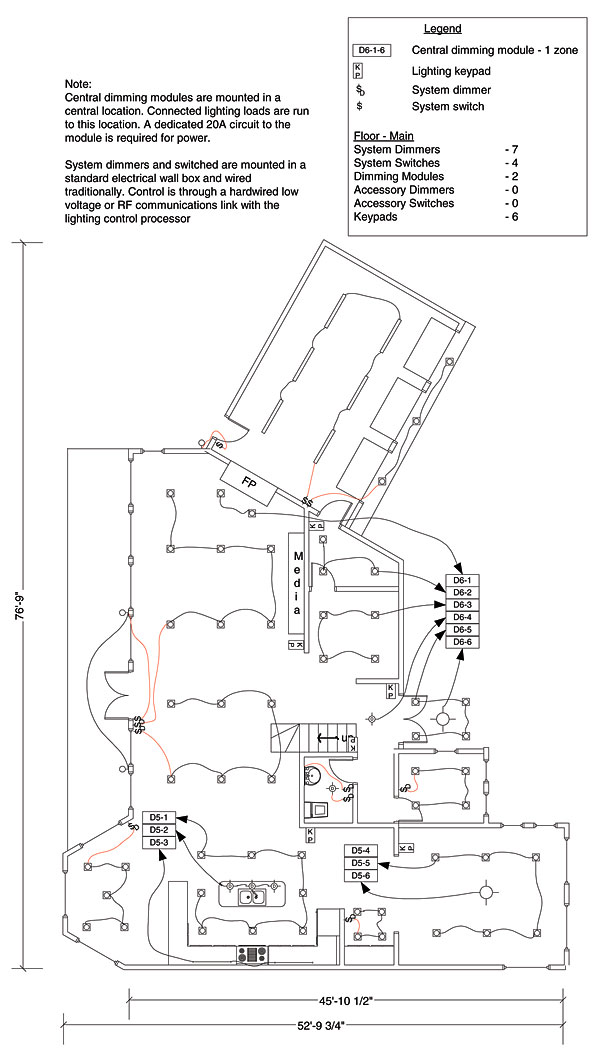
Vantage, another big player in the lighting-control industry, has recently joined the LeGrand family of companies with other custom-installation firms, including On-Q and Wiremold. Vantage is touting their new InFusion controller as an example of the evolution of the lighting-control system. No longer limited to lighting control, the InFusion processor broadens control capabilities to include A/V equipment, HVAC, and security systems. These disparate systems can now seamlessly integrate together to form a highly capable home-automation system.
In fact, Vantage recently added products outside the lighting-control arena, namely their new audio/video controllers and Axium 450 four-zone amplifier/ preamp. The company's communications manager, Derek Jensen, practically burst out of his chair as he explained about the InFusion system's capabilities. "It's the direction of the industry," he claimed. To maximize connectivity, the InFusion controller boasts USB and SD Card ports.
The InFusion system can incorporate a Vantage TPT (formerly TouchPoint) touchscreen control as an easy-to-use and extremely capable interface. While Lutron has yet to introduce a touchscreen control, their HomeWorks system features perhaps the widest variety of control keypads, with a plethora of keypad designs that promise to integrate seamlessly with any décor in virtually any situation. To keep designers happy, they offer a multitude of colors and finishes, including many that they target specifically to interior designers.
The InFusion, LiteTouch's 5000LC, and the latest iteration of Lutron's HomeWorks processors connect to the Ethernet world by incorporating a fully functional network jack (optional on the 5000LC). Lutron's processor enables a homeowner to monitor and control his or her lighting system from the LAN or the Internet. All retain a nod to legacy systems by keeping their serial ports for integration with systems that lack Ethernet or are better suited to serial control.
The LiteTouch 5000LC processor exerts extreme power. It can control over 2,000 different lighting circuits and 250 keypads—enough for all but the largest homes. It uses a unique card-based configuration, which allows for optimal configuration of the 5000LC for each individual system.
Multitasker
Most consumers think of Crestron as a control-systems company, but the longtime automation leader has participated in the lighting-control industry for many years, mainly targeting the commercial market. Recently, however, they've focused more on the burgeoning residential market for lighting control. Over the last few years, Crestron has added distributed lighting-control products to their existing line of centralized lighting-control products. This way, the customer can use their existing Crestron processor to also control their lighting.
Crestron has also embraced RF mesh network technology for communicating with their distributed switches and dimmers. While they also make a hard-wired solution that uses their traditional Cresnet for communication, their infiNET wireless mesh network solution is specifically designed for high reliability and easy installation. It also provides instantaneous feedback of a light's status to any control interface in the home, no matter what interface you used to control it. Crestron designed the system to allow their wireless infiNET and hardwired Cresnet products to act in combination for maximum flexibility and cost-effectiveness. As with Lutron and Vantage, most of Crestron's processors are Ethernet-enabled.
Bringing It Home
So, by now you're thinking, "This whole lighting-control thing really sounds great. Where can I get it?" Due to their complexity, the three leading lighting-control companies—Lutron, Vantage, and LiteTouch—all offer an authorized network of factory-trained custom home systems integrators and specialized electricians. They are uniquely qualified to design and install a system that will balance your needs and budget. All of these manufacturers have been building high-end lighting-control systems for the commercial and residential markets for over 20 years. Lutron remains an independent company, committed, in the words of Tieszen, to "leveraging the industry's largest engineering staff to continue to excel in the lighting control market."
Lighting control is one of the more functional enhancements you can make to your home. Properly dimmed lighting can create many moods in the same space. You'll have the ability to improve your home's look and feel, make your life easier, and save money at the same time. There are few things that can make that claim.
What You Get for the Money
The following are samples of various Lutron lighting-control systems.*
AuroRa System
Under $1,000 Installed and Programmed:
Wireless Controller (1)
Master Control (1)
Central Antenna (1)
Wall Dimmers (5)
Designer Inserts (5)
RadioRA Safe Entry Car Visor Package
Under $2,500 Installed and Programmed:
Car Visor Control Transmitters (2)
Multifunction Entry Master Control (1)
10-Button Tabletop Master Control (Large Button) (1)
600W Incandescent/MLV Dimmers (5)
Accessory Dimmers (2)
RF Signal Repeater (1)
HomeWorks 4 Series
System controls nine lighting loads from three master keypads.
Under $7,000 Installed and Programmed:
In-Wall Master Keypads (3)
In-Wall Dimmers and Switches (9)
In-Wall Remote Dimmers (3)
Auxiliary Equipment Interface (1)
Processor (1)
5,000-Square-Foot Package
System controls 60 lighting loads from 12 master keypads.
Under $20,000 Installed and Programmed:
In-Wall Master Keypads (12)
In-Wall Dimmers and Switches (36)
In-Wall Remote Dimmers (5)
Wall-Box Power Modules (24 zones of light) (4)
Auxiliary Equipment Interface (1) Processor (1)
* Note: These prices may vary according to the programming requirements of the individual client, local installation and programming labor rates, and the individual dealer.
- Log in or register to post comments
